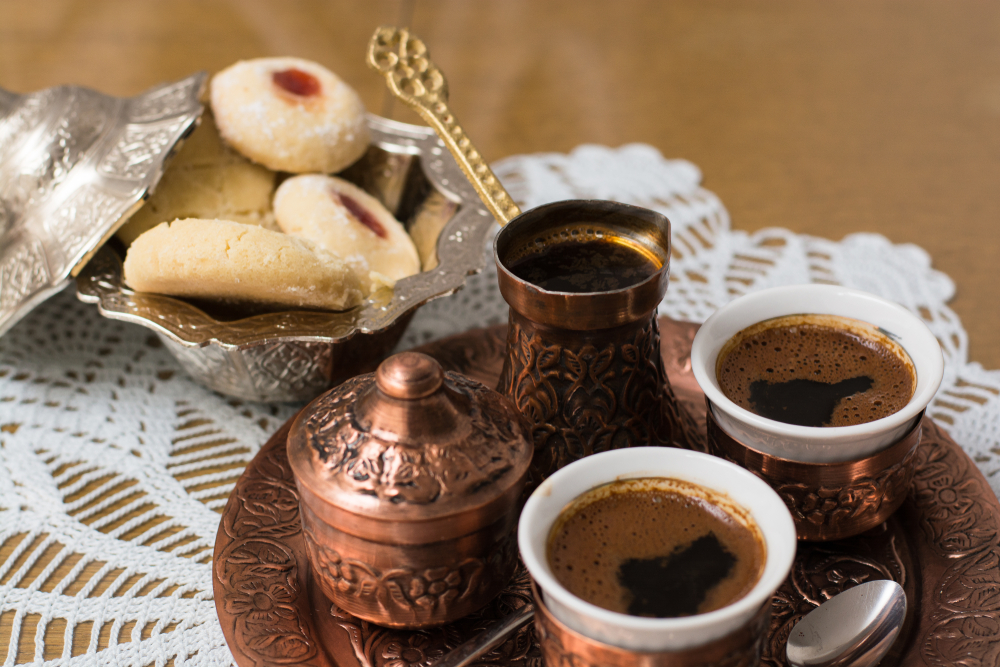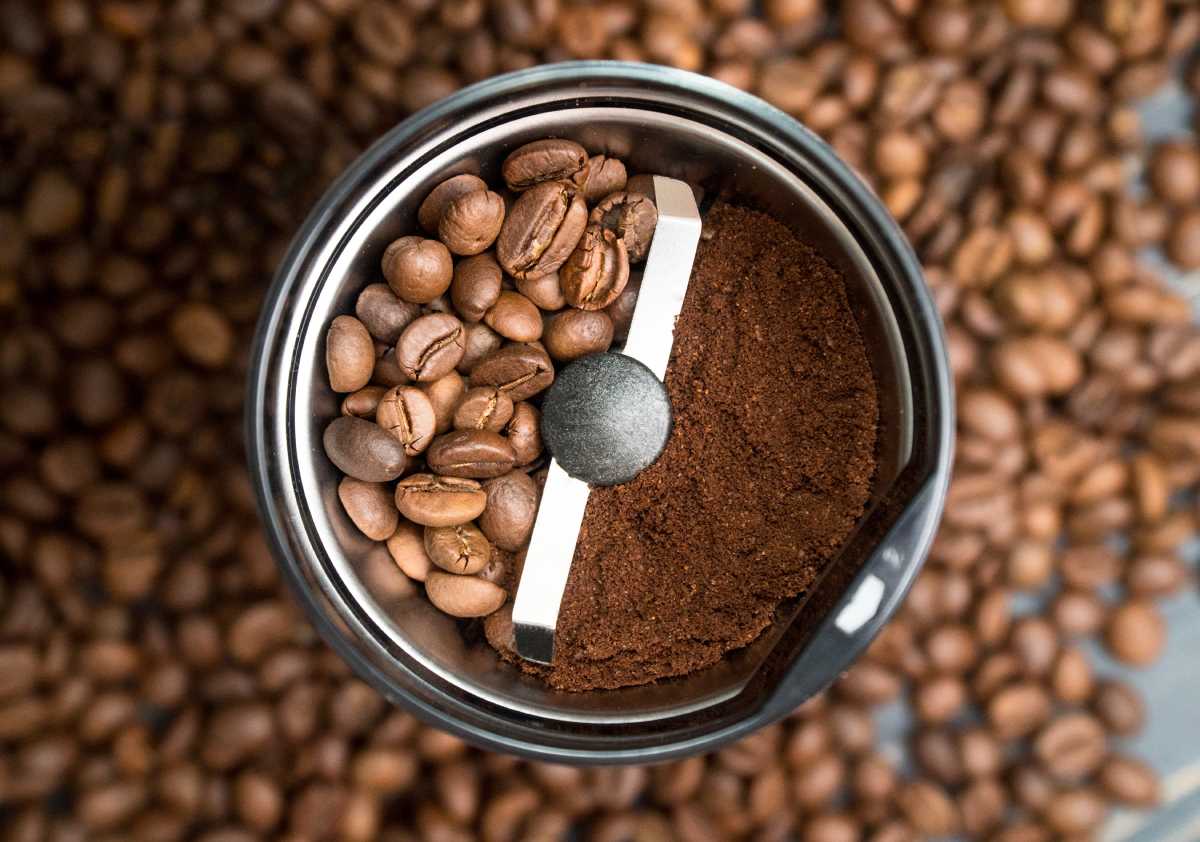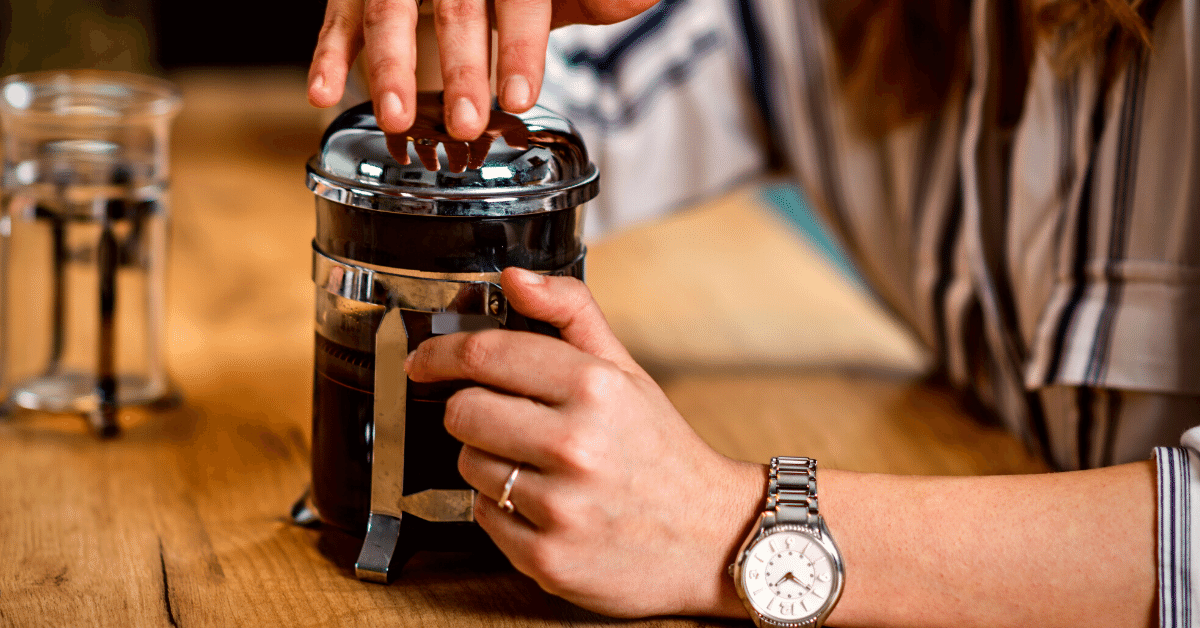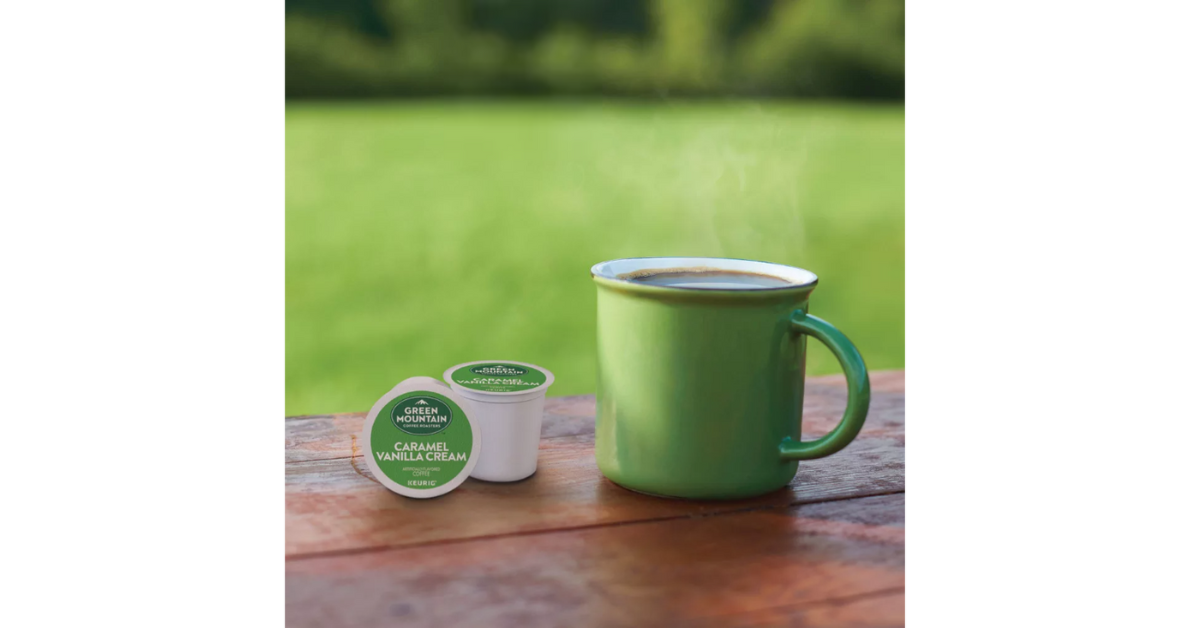Surrounded by its cultural legacy, Turkish coffee takes you on a journey into the tradition and extraordinary flavor. In this guide, we answer the questions – what is Turkish coffee, and how to prepare it?
Turkish coffee is not just fuel that gets you through the day. It’s a ritual.
But what is Turkish coffee exactly? It’s a black coffee prepared in a special brass pot called Cezve with extra-fine coffee grounds.
As someone who comes from a culture that drinks a lot of Turkish coffee, I can tell you all about this age-old tradition and how to prepare a perfect cup.
Let’s begin!
Origins and History of Turkish Coffee
As far as historians know, coffee originated and was first used in Africa. In Ethiopia, to be exact. A shepherd discovered that his goats who ate the berries from a certain tree acted more energetic than others. He then made a drink with leaves from that tree and discovered the energizing properties of the coffee plant.
The shepherd reported his findings to the monastery. Soon enough, the monks started making the drink from the berries and using it to get through their night prayers (pulling an all-nighter, if you will). The word about the drink started spreading, and the coffee began its worldwide journey.
First, it was grown on the Arabian Peninsula. In the 14th century, it was grown in the Yemeni district, and by the 15th century, it reached Mecca and Medina. The Muslims visited these cities during Hajj (an Islamic traditional annual pilgrimage) and took coffee to their homelands. By the 16th century, coffee was known and used in Persia, Egypt, Syria, and Turkey.
Already on the Arabic Peninsula, coffee was not drunk only at home but in public coffee houses. It was the first sign of what would become an important staple of social life. Drinking coffee as a social activity continued in the Ottoman Empire.
Firstly, coffee reached the Ottoman Empire at the beginning of the 1500s and was widespread during the era of Suleiman the Magnificent. After a while, coffee became a habit for both common people and high classes. It became a part of social and cultural life.
The first coffee house opened in 1555. Soon enough, coffee houses became the center of different social and cultural activities. They became a place where theatre plays were performed since no special building existed for this kind of art.
Knowing all this, it’s no wonder that Turkish coffee was inscribed on the Representative List of the Intangible Cultural Heritage of Humanity of UNESCO in 2013. It has great social value in Turkish culture, and it’s a symbol of hospitality and friendship.
Distinctive Characteristics of Turkish Coffee

First of all, the coffee ground used for making Turkish coffee is extra fine, almost like a powder. It’s even finer than grounds for espresso coffee or Moka pot. The coffee particles are less than 1mm in size.
This grind is perfect for the brewing method Turkish coffee requires. Since there is no filtration, the grounds end up in your cup. However, they sink to the bottom due to their fine grind. If the grind size is coarser, the ground would float on the surface of your cup and end up between your teeth (Yuck!).
Another result of extra-fine grind is the foam that’s formed at the top of your Turkish coffee, which is unique for this type of brewing method. The thick layer of foam is a trademark of Turkish coffee, and it’s traditionally an indicator of coffee quality and the host’s skill. Its absence is sort of a shame for the host.
The roast usually used for Turkish coffee is a medium roast. This roast is balanced, not too bitter or acidic. Specific notes depend on the origin, but they generally have a well-rounded, nutty, and mildly sweet flavor.
When it comes to consistency, Turkish coffee is thicker than other kinds of coffee due to the lack of filtration. This also makes it more aromatic and stronger.
Finally, the distinctive brewing method is one of the things that separates Turkish coffee from most of the other methods. Let’s see what it’s all about.
Brewing Turkish Coffee: A Step-by-Step Guide
This method is one of the oldest methods of brewing coffee, so it doesn’t require a lot. All you need is:
- long-handled brass or copper coffee pot called “cezve” (or “ibrik”)
- finely ground coffee
- water
- sugar (optional)
- cardamom (optional)
NOTE: To get extra-fine grounds, it’s best to grind coffee beans yourself. Freshly ground coffee is superior to pre-ground, and you can tweak the grind size to your liking. When choosing the grinder, check that it has “extra-fine” grind settings. Manual grinders usually have more adjustment settings. Traditionally, a special brass grinder is used for grinding the beans for Turkish coffee.
Step 1: Add coffee grounds and water to the cezve
When adding the ingredients, take care to respect the ratio, or your coffee might turn out too bitter or too mellow. The ratio should be 1:9 coffee to water. The amount of coffee you will be able to prepare depends on the size of your cezve, but keep in mind that traditional Turkish coffee is served in small 2-2.5 ounces (60-75 milliliters) cups. For example, in 120ml (2-cup cezve), you should add 14g of coffee. Use a coffee scale for precision.
Step 2: Place the cezve on a heat source
Traditionally, Turkish coffee is prepared in a pan of heated sand. (Yes, you read it right!) However, this method is rare, although you can still see it in some of the authentic coffee places in Turkey. A simpler and more regular way nowadays is just heating up the cezve on a stove or gas burner. The heat shouldn’t be too strong. Medium/low heat is sufficient. After heating it for approximately 30 seconds, stir the grounds into the water.
Step 3: Bring the coffee close to the boiling point but do NOT boil it
This is extremely important. If the coffee boils, the foam will most likely not form. When you see the foam rising, wait for it to reach the top of the rim of the cezve and then remove the cezve from the fire.
Step 4: Quickly pour the coffee into cups and let it sit
Don’t worry about the grounds coming into the cup when you pour it. Just let it sit for a while, and the grounds will fall on the bottom.
Serving and Drinking Etiquette
Turkish coffee is served in a small cup similar to a demitasse espresso cup. This cup is called a fincan. It’s made of ceramic, porcelain, or copper and usually has no handle. It’s decorated with different patterns, motifs, and colors connected with Turkish culture. Fincans are a matter of prestige in Turkish tradition, and collecting sets of these cups is even a hobby for some people.
Traditionally, next to the cup, you will find a glass of water and a Lokum (Turkish delight), a cube candy made based on a gel of starch and sugar. Additionally, there might be a piece of chocolate too. These sweets oppose the bitterness and intensity of Turkish coffee.
After waiting for the grounds to settle (which is actually the second brewing, in a way), you may start sipping your coffee!
Fortune Telling: Reading the Coffee Grounds
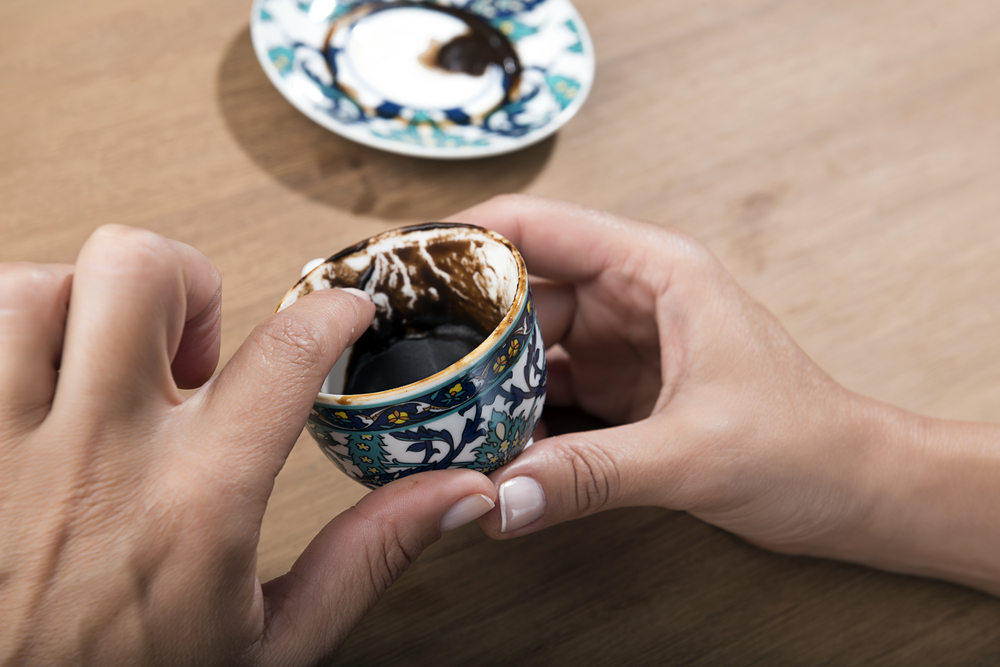
The most mysterious and interesting thing about the tradition and ritual behind Turkish coffee is, of course – fortune telling. Formally known as tasseography (reading the tea leaves, coffee grounds, or wine sediments), this method of divination is found in many cultures, including Turkish. And since Turkish coffee doesn’t require filtration, there will be plenty of grounds to read from.
Basically, this divination technique involves interpreting patterns found in coffee grounds after you finish drinking. It requires the cup to be inverted and left to sit like that for a while so parts of the ground fall down on the saucer. Then the shapes that are left in the cup are analyzed so the hidden meanings and symbols are revealed to tell the future (or even past and present) of the one who drank the coffee.
Reading the future from the coffee grounds has an important place in the tradition surrounding Turkish coffee, representing yet another element of its social value. So, make sure not to skip it if you want a true Turkish coffee experience.
Cultural Significance and Rituals
As I mentioned, Turkish coffee is not just a drink. It’s a ritual. It’s a symbol of hospitality and friendship and an important part of different social and cultural activities. Since it was brought to Turkey, it has been an important part of social meetings, political discussions, and ceremonies.
Coffee plays an important role in the pre-engagement meeting of the bride’s and groom’s families. If the bride-to-be prepares and serves the coffee flawlessly, it reflects her virtue of being a good wife. The groom is also evaluated by sitting, receiving, and sipping the coffee.
The bride may add some salt to the groom’s coffee to test his character. If he doesn’t show signs of dissatisfaction, it means he is patient and has a good temper. Another version is that the bride might add salt to show her dissatisfaction with the groom and a sign that she wants to stop the engagement.
So, be careful how you handle your coffee if you are engaging with a Turkish guy or a girl!
Health and Nutritional Aspects of Turkish Coffee
Turkish coffee is not much different than other types of coffee when it comes to nutritional and health aspects. It’s all a matter of the amount and stuff you add to it.
Regular black Turkish coffee contains 64 calories per 248 g serving. It has 16g of sugar, 0.02 mg of iron, 4.96 mg of calcium, and 114 mg of potassium.
Regarding the caffeine amount, it has 40-60g of caffeine per 2 fl oz cup.
Now, if you add sugar, spices, milk, or other additives, the nutritional value will change, obviously.
When it comes to health aspects, Turkish coffee has its pros and cons. Coffee (including Turkish coffee) may lower the risks of Alzheimer’s disease, type 2 diabetes, and cardiovascular diseases and improve overall health, according to scientists.
On the downside, studies showed that excessive amounts of coffee can lead to anxiety, sleep problems, and increased heart rate due to high amounts of caffeine. Also, Turkish coffee may raise blood cholesterol and triglyceride levels due to the lack of filtering, which would reduce the amount of cafestol.
Additional stuff you add to your cup may bring more benefits or downsides, so check on those and keep yourself informed.
In any case, coffee should be enjoyed in moderation to avoid negative effects. If you are sensitive to caffeine, decaf coffee might be a better option.
Turkish Coffee Around the World
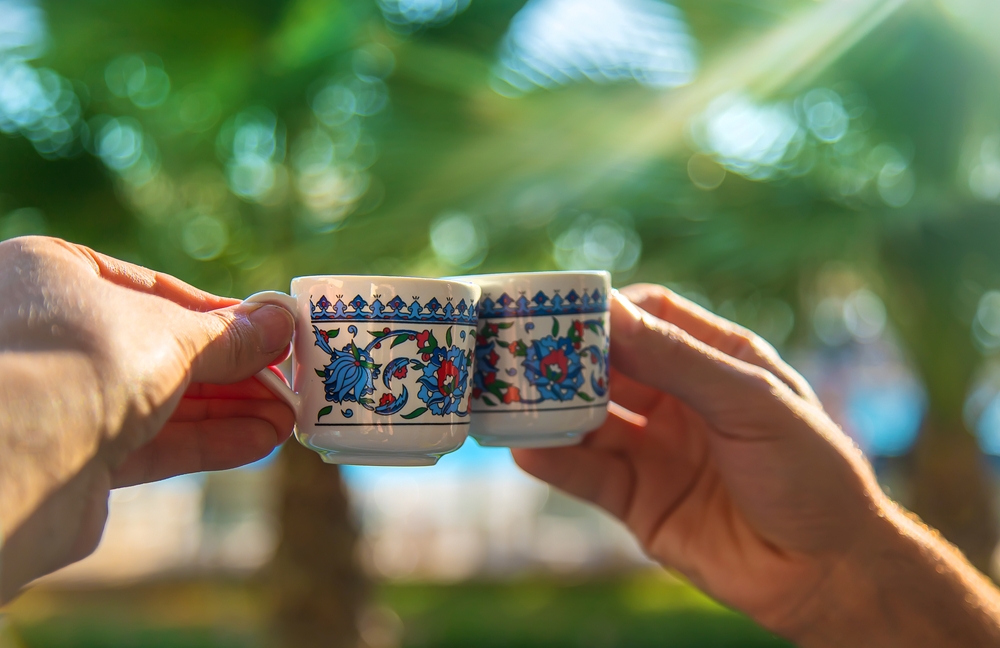
Different versions of Turkish coffee and its tradition are present in other countries, especially in nearby areas such as Greece, Balkan, and the Middle East. They are quite similar in the core, but there are some variations in brewing and serving. Here are some examples:
- Armenia (Armenian coffee/ Black coffee) – most commonly brewed with little sugar and served with a plate of baklava cake
- Greece (Greek coffee) – the same as Turkish coffee, except it’s served with Greek sweets, and sugar is added after brewing directly into the cup
- Czech Republic, Slovakia, Poland, and Lithuania (turecká káva or turek) – brewed without cezve, the grounds are put in the cup, and the boiling water is poured over.
- Serbia, Bosnia, Croatia, Slovenia, North Macedonia (bosanska kahva, turska kafa, domestic coffee) – very similar to Turkish coffee, but the coffee is added to the water after the boil. It can be served with sweets, but not necessarily.
Even in its country of origin, Turkish coffee has variations. Here are the most common:
- Sütlü Türk Kahvesi: Turkish coffee with milk
- Kül Kahvesi: Turkish coffee brewed on burning coals or a barbeque
- Damla Sakızlı Türk Kahvesi: Turkish coffee flavored with mastic (plant resin)
- Devebatmaz Kahvesi: The emphasis is on the foam
- Cilveli Kahve: Turkish coffee served with roasted and crushed almonds
- Dibek Kahvesi: Turkish coffee with added spices such as cacao, terebinth, carob, sahlep, and cream
- Mırra Kahvesi: Strongly brewed Turkish coffee with cardamom
- Tatar Kahvesi: Served with clotted cream (kaymak) in a special cup called Tostakay
- Hatay Kahvesi: Brewed with double-roasted coffee beans for a darker and stronger brew
- Süvari Kahvesi: Served in thin-waisted tea glasses
- Menengiç Kahvesi: Not an actual coffee, but ground terebinth fruits prepared with milk or water as a caffeine-free variant
Experiencing Turkish Coffee in Turkey
Visiting Turkey? Then you have a chance to try the best Turkish coffee and visit the most historical coffee places. Here are my recommendations:
- Mandabatmaz: An old but popular coffee shop on Istiklal Street in Istanbul, famous for the creamy foam of Turkish coffee.
- Fazıl Bey’in Türk Kahvesi: The founder of this coffee place, Mr. Fazil, invented a special formula for his Turkish coffee in 1920. The coffee shop still respects the old method, from roasting to brewing, and uses old-fashioned machines in the process. It’s located in the Asian part of Istanbul.
- Tahmis Kahvesi: This is one of the oldest coffee shops in the world. It’s located in Gaziantep, the sixth-most populous city in Turkey. It opened in 1635, and it’s the first coffee shop to serve Turkish coffee in the country.
You will definitely find a plethora of places where you can experience coffee culture in Turkey. Even though it’s an old tradition, it’s far from extinction.
Coffee consumption in Turkey has increased by an annual average of 15.6%, according to a study done by the International Coffee Organization. And although Western coffee chains are spreading in Turkey, traditional coffee still has its place, and it’s not going anywhere. And even more, it’s becoming more popular among young people, despite the increasing popularity of foreign brands. It’s because the coffee ritual is an integral part of social and cultural life and not just a fuel that you take “on to go.”
Recipe Box
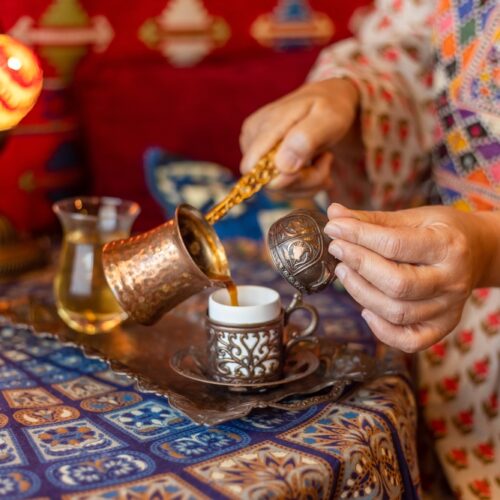
Turkish Coffee Recipe
Equipment
- cezve (special brass or copper pot)
- a small cup (60-75 ml)
- a stove or gas burner
Ingredients
- extra-fine coffee grounds (~7g of coffee per serving)
- water (60-75 ml per serving)
- sugar (optional)
- cardamom
Instructions
- Add coffee grounds and water to cezve. If you option to use sugar and/or cardamom, add it at this point too.
- Place it on the stove and mix the grounds into the water after half a minute.
- Wait for the foam to form, and when it reaches the rim of the cezve (before boiling), remove it from the stove.
- Quickly pour the coffee into the cup.
- Let to cup sit for a while while the grounds settle on the bottom.
- Serve it along with a glass of water and a Locum (Turkish delight).
Final Thoughts on Turkish Coffee
The rich and interesting history of Turkish coffee is one of the reasons why it’s still one of the most popular ways of drinking coffee in Turkey and nearby countries and a unique attraction for tourists and coffee lovers around the world.
Its simple brewing technique allows you to easily make this coffee at home, although you might need to go through trial and error to get that foam just right. So get your cezve, and get brewing!
Don’t forget to look into your cup afterward and take a peak into your future.
Want to discover other interesting ways of preparing coffee? Check our guide to the top 10 home coffee brewing methods.

